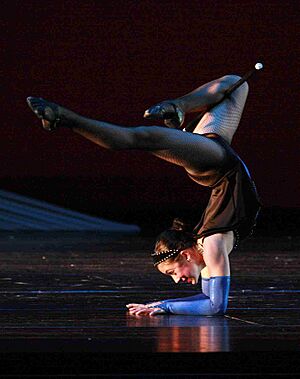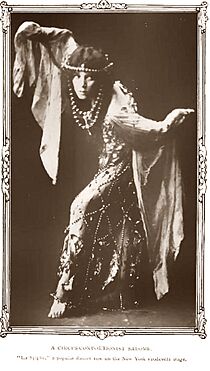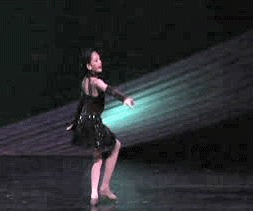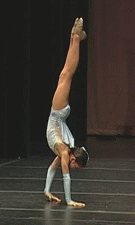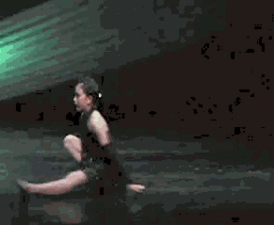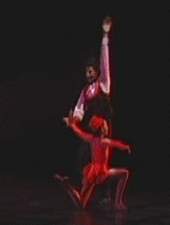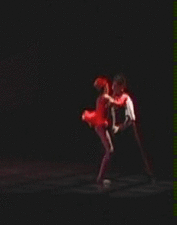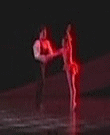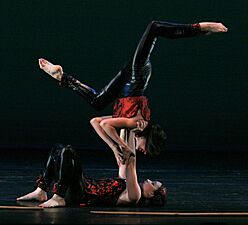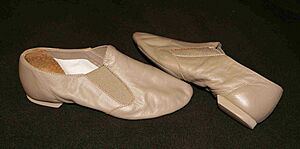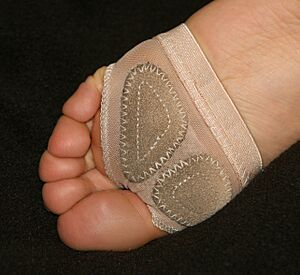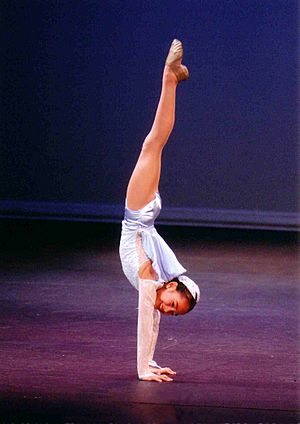Acro dance facts for kids
Acro dance is an exciting style of dance. It mixes classical dance moves with amazing acrobatic skills. Think of it as a blend of graceful dancing and cool flips or balances!
This dance style is very athletic. Its special routines combine dance and acrobatics perfectly. You'll see acro dance in many places. It's popular in competitive dance for students. You can also find it in professional dance shows and contemporary circus acts, like those by Cirque du Soleil.
Acro dance is different from acrobatic, artistic, or rhythmic gymnastics. Those are sports that use dance moves within a gymnastics setting. Acro dance, however, uses acrobatics within a dance setting.
Dancers and teachers often just call it acro. You might also hear it called acrobatic dance or gymnastic dance. It's a challenging style because dancers need to be good at both dance and acrobatic skills.
Contents
A Brief History of Acro Dance
Acro dance first appeared in the United States and Canada. This was in the early 1900s. It was part of popular shows called vaudeville. Vaudeville shows featured many different acts, like singing, comedy, and acrobatics.
Before 1900, people performed dance acts and acrobatic acts separately. But in the early 1900s, it became popular to combine them. Acro dance grew slowly over time. No single person invented it all at once.
Some early performers were very famous. Sherman Coates was one of the first acrobatic dancers people remembered. Tommy Woods was known for his slow-motion acro dance. He moved perfectly with the music. In 1914, Lulu Coates started a group called the Crackerjacks. They performed acro dance until 1952.
After vaudeville shows became less popular, acro dance changed a lot. A big change was adding ballet technique. This made the dance moves more precise and graceful. Old vaudeville acro was often just acrobatics with music. Modern acro dance is truly dance, with acrobatic moves fitting into the routine.
What Makes Acro Dance Special?
A key part of acro dance is how smoothly dancers move. They go from a dance step right into an acrobatic trick. Then they transition back into dance. It all looks very graceful.
For a routine to be called acro, it needs a good amount of actual dance. It's not just a series of acrobatic moves. For example, a gymnastics floor routine has many acrobatic parts. But it usually has less technical dance. Also, gymnasts often don't have those smooth transitions. Acro dance also doesn't use special equipment, unlike some gymnastics.
Dance Styles in Acro
The dance moves in acro come from several styles. These include ballet, jazz, lyrical, contemporary, and modern dance. While acro can use other dance moves, these styles form its core. If a routine doesn't have these dance foundations, it might not be considered acro dance.
Acrobatic Moves, or "Tricks"
The acrobatic moves and balance poses in acro dance are called tricks. There are many different tricks. They vary a lot in how hard they are to do. The type of tricks performed also depends on how many dancers are involved.
Solo Tricks
Solo tricks are performed by one dancer. They can be part of a solo or a group dance. Here are some examples:
- Bridge / Backbend
- Cartwheel
- Roundoff
- Front walkover
- Back walkover
- Valdez
- Leg Extensions
- Handstand
- Bow and Arrow Handstand
- Hollowbody handstand
- Backwards split rolls
- Illusions
- Chest stand
- Elbow / Forearm Balance
- Handspring
- Kip-up
- Side aerial
- Front tuck
- Back tuck
- Back layout
-
One-hand front walkover
BethanyRose Boutwell, an acro dance teacher since 2012, explains: "Strength, flexibility, and balance are also major pillars of Acro Dance. Poses often inspired by contortion are used alongside agility (tricks) and dance technique." An example of strength needed is a press-up handstand.
Flexibility is also very important for acro dancers. Here are some flexibility poses:
- Bridge / Backbend
- Right Split
- Left Split
- Center Split
- Chest Stand
- Bow and Arrow Handstand
- Hollow body handstand
Double Tricks (Partnering)
Double tricks, also called partnering tricks, need two dancers. They are inspired by partner dances and circus acts. An example is the pitch tuck. In this trick, one dancer makes a "saddle" with their hands. The second dancer steps onto the saddle. The first dancer then pushes the saddle upward. This sends the second dancer into the air, spinning backward. They land on their feet after a full turn. Acro partners also do lifts and adagio moves.
Group Tricks
Group tricks usually need three or more dancers. Smooth transitions between moves are still very important to make it acro dance. Examples include:
- Bridge pyramid
- Triple cartwheel
What Dancers Wear
Footwear
Acro dances are often performed on hard stages. These surfaces are very different from soft gymnastics floors. Gymnasts usually perform barefoot on cushioned floors. Acro dancers, however, rarely dance barefoot. They use special footwear like acro shoes or foot thongs. These provide grip and cushioning.
All common acro footwear offers both grip and cushioning. Performance surfaces can be rough. So, acro footwear also protects the bottom of the foot from scrapes. This protection is especially important on the ball of the foot. This area experiences a lot of friction during dance turns and leaps.
Good grip is vital to prevent slipping. Slipping could lead to dangerous falls on a hard floor. Cushioning helps soften the impact when doing tricks. This includes moves like tucks and layouts, where feet hit the floor at high speed. Cushioning is extra important if a special Marley floor isn't available. Uncovered surfaces have no cushioning and can be very hard.
Acro Shoes
Acro dancers most often wear jazz dance shoes. Dancers usually call them acro shoes. Manufacturers might call them jazz boots or jazz ankle boots. They are usually slip-on shoes without laces. They have tight-fitting leather tops. This design keeps the dancer's feet from moving inside the shoes.
Acro shoes are very flexible. They have thin, soft leather tops and split soles. This helps dancers achieve good dance form and acrobatic control. The sole is made of soft rubber. This gives great grip and cushioning. It also protects the entire bottom of the foot from scrapes.
Foot Thongs
Sometimes, acro dancers wear foot thongs. These are also known as Dance Paws or FootUndeez. Foot thongs are partial foot covers that slip on. They only protect the ball of the foot. Dancers sometimes prefer them for how they look. Flesh-colored foot thongs make it seem like the dancer has bare feet. But they still offer some grip, cushioning, and protection.
Clothing
Acro dancers typically wear flexible, form-fitting clothing. This is for both safety and how it looks. Tight clothing is better than loose clothing. Loose clothes can get in the way and make it harder to control movements. This is very important when doing tricks. Losing control can lead to serious injury.
Besides safety, form-fitting clothing also shows off a dancer's body lines. This can make an acro dance performance much more visually impressive.
Competitive acro dancers often wear costumes for competitions. Acro costumes might have loose fabric pieces, like short skirts. However, the size and placement of these pieces are carefully planned. This ensures they don't create any safety risks. For extra safety, skirts are sometimes pinned or stitched at the back. This keeps them from hanging down when a dancer is upside down, like in hand walking. It prevents the skirt from getting tangled in hair or a headpiece.
Acro Dance Competitions
The rules for acro dance are not always the same in the competitive dance world. Some competition companies require an acro routine to have at least four or five tricks. They might also say that no more than half of the routine should be acrobatics. Other companies might require exactly, or more than, half of the routine to be acrobatic.
Also, at some competitions, an acro dance might fit into a specific "acro dance" category. At others, it might be in a similar category like "acro/gym" or a general "open" category. Because of these differences, a single acro routine might need to be entered into different categories at different competitions.


